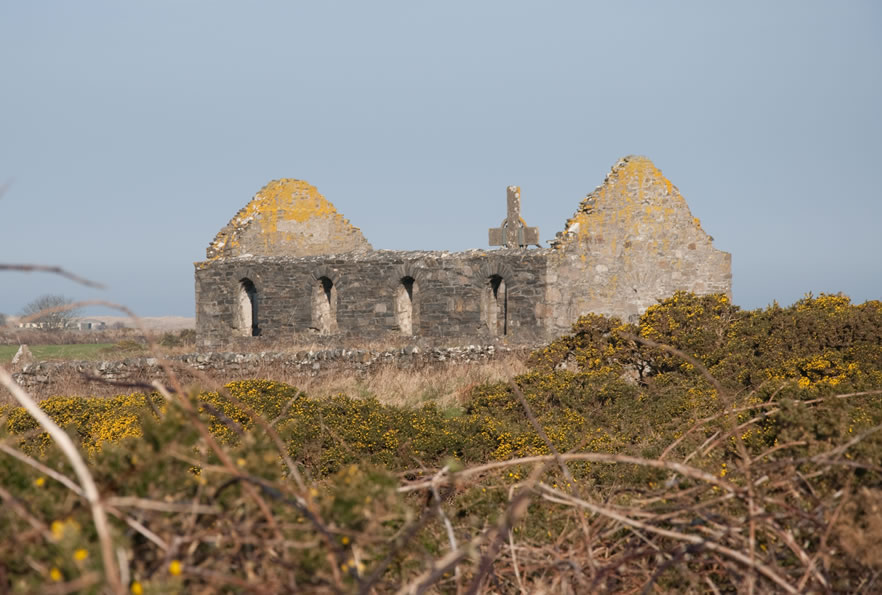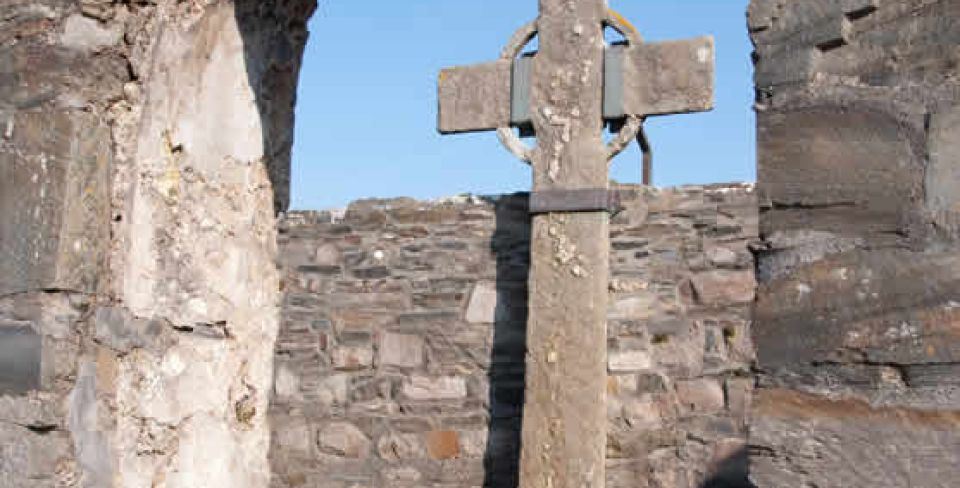2.9 Ray Church
Ray (pronounced ‘Rye’ in Irish, Ráith), is an ancient church site remarkable for its links with the abbey of Iona, and for its very tall high cross – 5.56m, one of the tallest if not the tallest in Ireland. The church stands on the east bank or the river Ray and near its estuary. From the 6th to the 8th centuries the river was a boundary between two small kingdoms, the Cineál Duach on the east of the river and the Cineál Lughdach on the west.

In the 7th century no fewer than four very important abbots of Iona came from the Cineál Duach. Almost certainly, this was their home church. The great high cross now stands inside the ruins which date mainly from the 17th century. As there is no decoration on the cross itself it is difficult to date it but it bears a striking similarity to the form and scale of St John’s Cross on Iona (of about AD 775) – arguably the oldest of the ringed (so-called ‘Celtic’) stone crosses in these islands – and may be contemporary with it. An elaborate legend says that the Ray cross was made on Muckish mountain for St Colmcille who intended to bring it to Tory Island but gave it instead as a gift to the local saint, Fionán, who had miraculously retrieved the Colmcille’s lost gospel book. In modern times, until recently, the cross – fallen and broken – lay in the adjoining graveyard probably at or close to its original location.
Cloughaneely and Tory Island
- 2.1 An Chros Tau
As you arrive in Tory the first site to greet you is the Tau Cross. Sitting high on a plinth, the T-shaped stone cross is a symbol of the island’s Christian heritage. The cross is thought to date from early medieval times and is carved from one piece of mica...
- 2.2 The Old Graveyard
The graveyard is believed to be on the site of an Teampull Buí which was the main church of a former monastery on Tory. An early Ordnance Survey map shows the remains of ‘St Columkille’s church’ in the southwest corner of the graveyard although no remains are visible today. There are many...
- 2.3 The Bell Tower
The Bell Tower is the only surviving round tower in Donegal. Although it's nearly 13 metres tall, it is among the smallest of these towers in Ireland. Its date is not known but could be as late as the 12th century. The granite stones used to make the tower would...
- 2.4 St John’s Altar
This altar dedicated to St John the Baptist is just beside the Bell Tower. There are a number of stones here - including a stone trough, decorated stones and slabs, a quern (millstone) and the remains of the base of a cross. It is said that the hollow stones were used...
- 2.5 St Brigid’s Oratory
The stone altar of St Brigid lies between the islanders’ houses. On top of the altar are three quern stones (used for grinding corn) and two granite slabs. As well as Ulaí Bhríde there are remains of two other small chapels - or oratories - on the island. At one...
- 2.6 Church of the Seven
These are the only chapel remains on Tory Island. In Irish this place is called Móirsheisear which translates as ‘big number six’ and which is an old Irish word for the number seven. Islanders tell the story that the site is the tomb of seven people who drowned when their boat was...
- 2.7 Rock of the Hound
© Alan Sproull Local tradition says that when Colmcille first arrived at Tory island he was met by the local king Oilill who refused to let him land. Colmcille asked if he could simply have a piece of land the same size as his cloak on which he could build...
- 2.8 Cnoc Na Naomh
Local legend says that Colmcille stood on this hill - Cnoc na Naomh - with his companions Saints Fionán, Dubthach and Begley. As they stood here above Magheraroarty, they discussed who would have the task of converting the Tory islanders to Christianity. They decided to answer the question by throwing...
- 2.9 Ray Church
Ray (pronounced ‘Rye’ in Irish, Ráith), is an ancient church site remarkable for its links with the abbey of Iona, and for its very tall high cross - 5.56m, one of the tallest if not the tallest in Ireland. The church stands on the east bank or the river Ray...
- 2.10 Tullaghobegley
The ruins of the late medieval Tullaghobegley Church and graveyard lie on a small mound just to the south of Falcarragh. This tulach - or ‘low hill’ or ‘mound’ - was probably used for tribal inauguration ceremonies or other gatherings. Remains of other ancient monuments can be found nearby including burial grounds,...










Bòrd na Gàidhlig
Great Glen House
Leachkin Road
Inverness
Scotland, IV3 8NW
(+44) 01463 225454
colmcille@gaidhlig.scot
Colmcille
Foras na Gaeilge, 2-6 Queen Street
Belfast
Northern Ireland
BT1 6ED
(+44) 028 9089 0970
colmcille@forasnagaeilge.ie
Colmcille
Foras na Gaeilge, An Chrannóg
Na Doirí Beaga
Gaoth Dobhair
Donegal, Ireland. F92 EYT3
(+353) 074 9560113
colmcille@forasnagaeilge.ie


